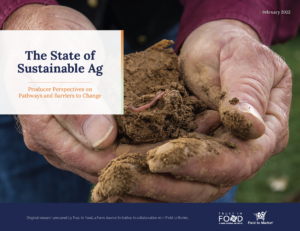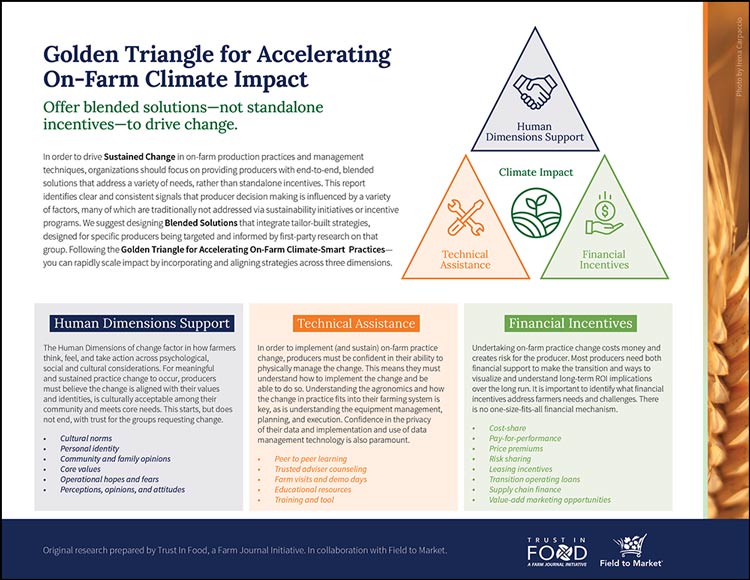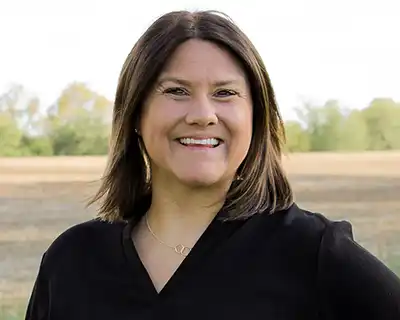There has never been more urgency for governments, NGOs and supply chain partners to address issues like climate change, biodiversity, and soil and water health. As more and more ideas for a better world develop, the line of organizations with agricultural program pitches has stretched around the block for the chance to knock on farmers doors. They recognize that no one is in a better position than farmers to unlock agriculture’s vast, badly needed potential to provide climate and regenerative benefits.
“Farmers are the original conservationists” is a phrase heard more and more often. Here at Trust In Food, we have nearly 150 years of Farm Journal history — combined with our research and brain trust of farmer knowledge through America’s Conservation Ag Movement, Trust In Beef and other initiatives — to prove just how true that maxim rings.
But when interests outside of agriculture say those words, something is getting lost in translation. If producers value land stewardship (they do), consumers and government leaders are eager to see climate-smart production (they are), and food and beverage companies are working to get regenerative products into the marketplace (this is happening as we speak), why has agriculture’s progress across multiple environmental indicators seemingly plateaued?
Farmer responses to new research from Trust In Food in partnership with Field to Market: The Alliance for Sustainable Agriculture might provide some answers. We surveyed 542 farmers, largely row-crop farmers at multiple scales, across 42 states. Their insights are central to the 2022 edition of “State of Sustainable Ag,” published Feb. 15.

Three underpinning concepts can steady the stepping stool that gives farmers, ranchers and growers a leg up on adopting sustainable practices, the report reveals. Coined the “Golden Triangle for Accelerating On-Farm Climate-Smart Ag“, the three keys to farmer success are:
- Human Dimensions Support
- Technical Assistance
- Financial Incentives
The implications of this model must be considered when reviewing systems, intended to support farmers on their conservation journeys, which largely focus on financial incentives alone. It is certainly true that the “overwhelming majority of producers” surveyed (76%) indicated that profit motivations are their No. 1 priority when assessing a farm’s performance. Addressing the balance sheet of climate-smart and regenerative agriculture is logical, positive and vitally necessary.

However, the 2022 State of Sustainable Ag expands on that theme to show that while financial incentives are gateway requirements, they are insufficient on their own. The report builds on past research to show that new insights and farmer engagement can be achieved by examining influential incentives, “softer motivations” and underlying barriers.
“It can be easy to focus on the most visible or reported barrier,” the report explains. “But the role that the remaining barriers play in further compounding a farm operation’s inability to adopt conservation practices should be explored.”
For example, 53% of survey respondents do not believe downstream demand should influence how they run their farms at all. This suggests there are economic and marketplace barriers. Perhaps more could be done to create market signals for farmers who need concrete evidence that adjusting operations to meet end-user demand makes good business sense.
Meanwhile, only a third of farmers report being part of a supply chain sustainability program because of the urging of a trusted adviser. A quarter haven’t joined a program because they don’t believe participation would be worth their time. This suggests that additional barriers include a lack of access to information and a perception that sustainability programs are a hassle.
Our report proposes that it’s high time to address these multiple, critical Human Dimensions Support factors. Organizations seeking to scale sustainable agriculture owe it to farmers to authentically demonstrate they are on the same team. Attention to the human dimension can be a big step in the right direction, and it can create space for more producers to seek out and benefit from financial and technical support that could increase profitability and market access down the line.
“Business likely cannot (in most cases) be separated from the personal identity and independence of the producer themselves.”
2022 State of Sustainable Ag
Alignment of sustainability programs and services with producers’ lived experiences and values, including through social support such as farmer learning communities, is a central theme of Trust In Food’s programming. The 2022 State of Sustainable Ag provides a path forward for all of us working to support and accelerate sustainability outcomes in agriculture. We invite the use of its insights to ensure we are all providing multiple, blended solutions that support farmers in voluntary conservation adoption in the coming year.
To download the full report, visit: https://bit.ly/Sustainable-Ag-Report-22



